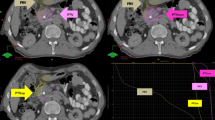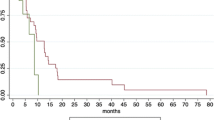Abstract
Purpose
The aim of this study was to evaluate the role of stereotactic body radiotherapy (SBRT) as adjuvant therapy for resected pancreatic adenocarcinoma with close or positive margins.
Methods
Between September 2006 and January 2010, 24 patients were treated with adjuvant SBRT following surgical resection. Eight (33.3%) patients had close margins of 1–2.5 mm to the retroperitoneal, vascular structures, and periduodenal adipose tissue. Sixteen (66.7%) patients had positive margins at retroperitoneal margin and vascular structures. Twenty-three patients received 24 Gy (20–24 Gy) in one fraction, and one had 30 Gy in three fractions. The median target volume was 11 cc (4.5–30 cc). Eighteen patients were treated with the Cyberknife® Robotic Radiosurgery System and six patients were treated with Trilogy™ intensity-modulated radiosurgery. Kaplan–Meier survival analyses were used to estimate freedom-from-local-progression (FFLP), and overall survival (OS) rates. PET/CT or CT was used to monitor disease recurrence following SBRT.
Results
The median follow-up for all patients was 12.5 months (1.4–39.5 months), and among surviving patients it was 16.3 months (2–39.5 months). The FFLP rates at 6 months, 1 and 2 years were 94.7%, 66%, and 44%, respectively. Overall, FFLP was achieved in seven (87.5%) patients with close margins, and 10 (62.5%) with positive margins. After SBRT, 19 patients resumed or started a 6-month course of gemcitabine-based chemotherapy at a median interval of 18 days (range, 9–31 days) post-SBRT. The median OS was 26.7 months and the 1- and 2-year OS rates were 80.4% and 57.2%, respectively. Of the 24 patients, 12 (50%) developed distant metastases of whom two (25%) had close margins and 10 (62.5%) had positive margins. Ten patients (41.7%) were free of progression at last follow-up (range, 3–39.5 months). Three patients (12.5%) had grade 1–2 acute GI toxicities, and two patients (8.3%) had grade 1 and 2 late toxicities. No patients experienced grade 3 or 4 toxicity, including bowel perforation, secondary to SBRT.
Conclusions
Our data suggest that adjuvant SBRT for resected pancreatic cancer can be achieved with minimal toxicity. This shorter treatment course allowed initiation of systemic chemotherapy shortly after the completion of SBRT.



Similar content being viewed by others
References
American Cancer Society. Cancer Facts & Figures 2009. Atlanta: American Cancer Society; 2009.
Li D, Xie K, Wolff R, et al. Pancreatic cancer. Lancet. 2004;363:1049–57.
Cameron JL, Riall TS, Coleman J, Belcher KA. One thousand consecutive pancreaticoduodenectomies. Ann Surg. 2006;244(1):10–5.
Richter A, Niedergethmann M, Sturm JW, Lorenz D, Post S, Trede M. Long-term results of partial pancreaticoduodenectomy for ductal adenocarcinoma of the pancreatic head: 25-year experience. World J Surg. 2003;27(3):324–9.
Wagner M, Redaelli C, Lietz M, Seiler CA, Friess H, Buchler MW. Curative resection is the single most important factor determining outcome in patients with pancreatic adenocarcinoma. Br J Surg. 2004;91(5):586–94.
Yeo CJ, Cameron JL, Lillemoe KD, et al. Pancreaticoduodenectomy for cancer of the head of the pancreas. 201 patients. Ann Surg. 1995;221(6):721–31.
Garcea G, Dennison AR, Pattenden CJ, Neal CP, Sutton CD, Berry DP. Survival following curative resection for pancreatic ductal adenocarcinoma. A systematic review of the literature. J Pancreas. 2008;9(2):99–132.
Swartz MJ, Hsu CC, Pawlik TM, et al. Adjuvant chemoradiotherapy after pancreatic resection for invasive carcinoma associated with intraductal papillary mucinous neoplasm of the pancreas. Int J Radiat Oncol Biol Phys. 2010 Mar 1;76(3):839–44.
Herman JM, Swartz MJ, Hsu CC, et al. Analysis of fluorouracil-based adjuvant chemotherapy and radiation after pancreaticoduodenectomy for ductal adenocarcinoma of the pancreas: results of a large, prospectively collected database at the Johns Hopkins Hospital. J Clin Oncol. 2008;26:3503–10.
Neoptolemos JP, Dunn JA, Stocken DD, et al. Adjuvant chemoradiotherapy and chemotherapy in resectable pancreatic cancer: a randomized controlled trial. Lancet. 2001;358(9293):1576–85.
Neoptolemos JP, Stocken DD, Friess H, et al. A randomized trial of chemoradiotherapy and chemotherapy after resection of pancreatic cancer. N Engl J Med. 2004;350(12):1200–10.
Oettle H, Post S, Neuhaus P, et al. Adjuvant chemotherapy with gemcitabine versus observation in patients undergoing curative-intent resection of pancreatic cancer. A randomized controlled trial. JAMA. 2007;297(3):267–77.
Stocken DD, Buchler MW, Dervenis C, et al. Meta-analysis of randomized adjuvant therapy trials for pancreatic cancer. Br J Cancer. 2005;92(8):1372–81.
Chang DK, Johns AL, Merrett ND, et al. Margin clearance and outcome in resected pancreatic cancer. J Clin Oncol. 2009;27:2855–62.
Heron DE, Ferris RL, Karamouzis M, et al. Stereotactic body radiotherapy for recurrent squamous cell carcinoma of the head and neck: results of a phase I dose-escalation trial. Int J Radiat Oncol Biol Phys. 2009. doi:10.1016/j.ijrobp.2008.12.075. Published on May 21, 2009.
Rwigema JC, Heron DE, Ferris RL, et al. Fractionated stereotactic body radiation therapy in the treatment of previously-irradiated recurrent head and neck carcinoma—updated report of the University of Pittsburgh experience. Am J Clin Oncol. 2010;33(3):286–93.
Rwigema JC, Heron DE, Ferris RL, Andrade RS, Gibson MK, Yang Y, Ozhasoglu C, Argiris AE, Grandis JR, Burton SA. The impact of tumor volume and radiotherapy dose on outcome in previously-irradiated recurrent squamous-cell carcinoma of the head and neck treated with stereotactic body radiation therapy. Am J Clin Oncol. 2010 Oct [In Press].
Rwigema JC, Parikh SD, Heron DE, Howell M, Zeh H, Moser AJ, et al. Stereotactic body radiotherapy in the treatment of advanced adenocarcinoma of the pancreas. Am J Clin Oncol. 2010;33(3):286–93.
Chang DT, Schellenberg D, Shen J, et al. Stereotactic radiotherapy for unresectable adenocarcinoma of the pancreas. Cancer. 2009;115:665–72.
Koong AC, Le QT, Ho A, et al. Phase I study of stereotactic radiosurgery in patients with locally advanced pancreatic cancer. Int J Radiat Oncol Biol Phys. 2004;58:1017–21.
Mahadevan A, Jain S, Goldstein M, Miksad R, Pleskow D, Sawhney M, Brennan D, Callery M, Vollmer C. Stereotactic Body Radiotherapy and Gemcitabine for Locally Advanced Pancreatic Cancer. Int J Radiat Oncol Biol Phys. 2010 Feb 18. [Epub ahead of print]
Sanders MK, Khalid A, Fasanella KE, et al. EUS-guided fiducial placement for stereotactic radiosurgery in pancreatic cancer. EUS-guided fiducial placement for stereotactic radiosurgery in pancreatic cancer. Gastrointest Endosc. 2008;67(5):AB201.
Birkmeyer JD, Siewers AE, Finlayson EV, et al. Hospital volume and surgical mortality in the United States. N Engl J Med. 2002;346(15):1128–37.
Buchler MW, Friess H, Wagner M, Kulli C, Wagener V, Z’graggen K. Pancreatic fistula after pancreatic head resection. Br J Surg. 2000;87(7):883–9.
van Heek NT, Kuhlmann KF, Scholten RJ, et al. Hospital volume and mortality after pancreatic resection: a systematic review and an evaluation of intervention in the Netherlands. Ann Surg. 2005;242(6):781–8.
Shah AP, Strauss JB, Abrams RA. Review and commentary on the role of radiation therapy in the adjuvant management of pancreatic cancer. Am J Clin Oncol. 2010;33(1):101–6.
Griffin JF, Smalley SR, Jewell W, et al. Patterns of failure after curative resection of pancreatic carcinoma. Cancer. 1990;66:56–61.
Tepper J, Nardi G, Sutt H. Carcinoma of the pancreas: review of MGH experience from 1963 to 1973. Analysis of surgical failure and implications for radiation therapy. Cancer. 1976;37:1519–24.
Varadhachary GR, Tamm EP, Abbruzzese JL, et al. Borderline resectable pancreatic cancer: definitions, management, and role of preoperative therapy. Ann Surg Oncol. 2006;13(8):1035–46. Epub 2006 Jul 24.
Gastrointestinal Tumor Study Group. Treatment of locally unresectable carcinoma of the pancreas: comparison of combined-modality therapy (chemotherapy plus radiotherapy) to chemotherapy alone. J Natl Cancer Inst. 1988;80:751–5.
Neoptolemos JP, Stocken DD, Dunn JA, Almond J, Beger HG, Pederzoli P, et al. Influence of resection margins on survival for patients with pancreatic cancer treated by adjuvant chemoradiation and/or chemotherapy in the ESPAC-1 randomized controlled trial. Ann Surg. 2001;234:758–68.
Winter JM, Cameron JL, Campbell KA, Arnold MA, Chang DC, Coleman J, et al. 1423 pancreaticoduodenectomies for pancreatic cancer: a single-institution experience. J Gastrointest Surg. 2006;10:1199–210.
Sohn TA, Yeo CJ, Cameron JL, Koniaris L, Kaushal S, Abrams RA, et al. Resected adenocarcinoma of the pancreas-616 patients: results, outcomes, and prognostic indicators. J Gastrointest Surg. 2000;4:567–79.
Westgaard A, Tafjord S, Farstad IN, Cvancarova M, Eide TJ, Mathisen O, et al. Resectable adenocarcinomas in the pancreatic head: the retroperitoneal resection margin is an independent prognostic factor. BMC Cancer. 2008;8:5.
Acknowledgments
This study was supported by the American Society for Radiation Oncology.
Conflict of Interest Notification
The authors state that they have no conflicts of interest.
Author information
Authors and Affiliations
Corresponding author
Rights and permissions
About this article
Cite this article
Rwigema, JC.M., Heron, D.E., Parikh, S.D. et al. Adjuvant Stereotactic Body Radiotherapy for Resected Pancreatic Adenocarcinoma with Close or Positive Margins. J Gastrointest Canc 43, 70–76 (2012). https://doi.org/10.1007/s12029-010-9203-7
Published:
Issue Date:
DOI: https://doi.org/10.1007/s12029-010-9203-7




